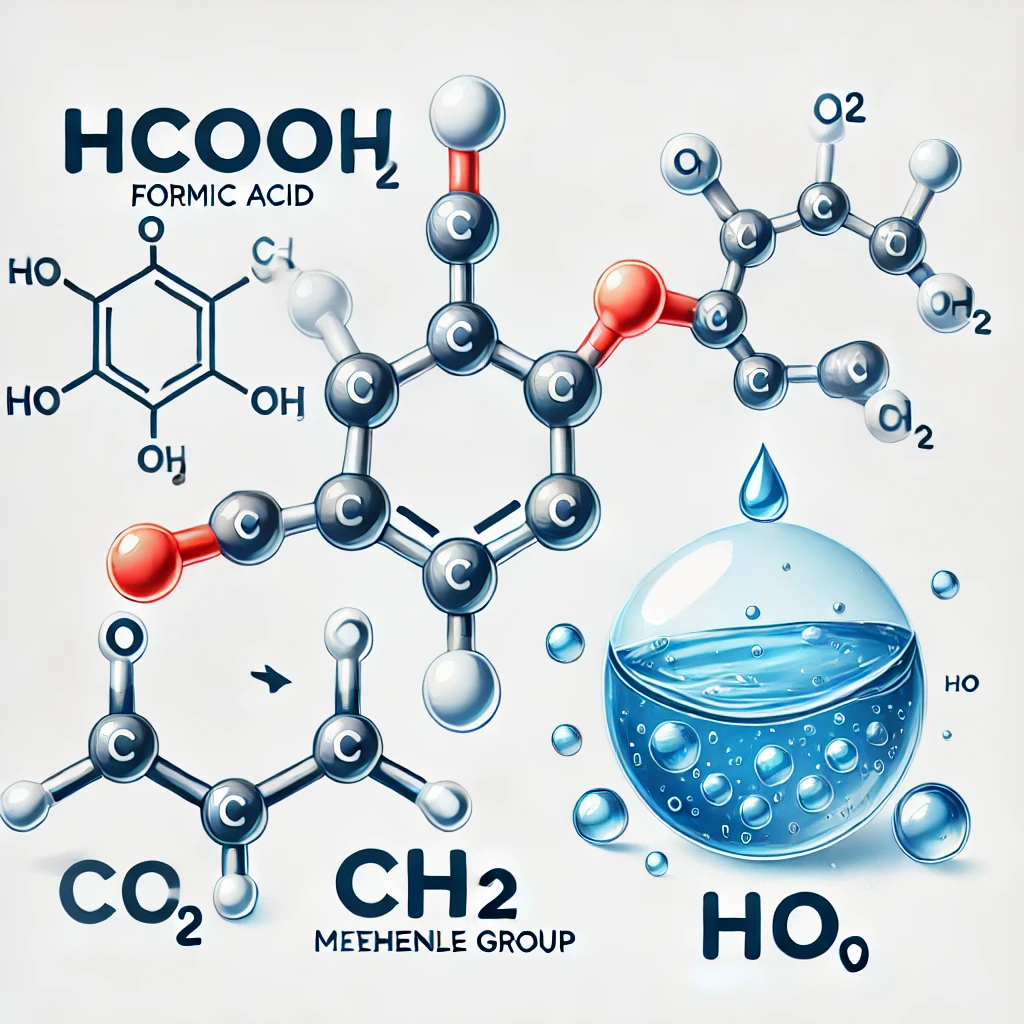Chemistry
Understanding the Chemical Reaction: hcooch ch2 h2o Explained

The phrase hcooch ch2 h2o may look like a cryptic formula at first glance, but it holds scientific relevance, especially in organic chemistry. These are shorthand notations representing formic acid (HCOOH), a methylene group (CH2), and water (H2O). This combination appears in various biochemical and synthetic chemical processes.
Understanding the behavior of these compounds together helps researchers and students grasp the basics of carboxylic acids, simple hydrocarbons, and their reactions with water. In this article, we’ll break down each component, explore potential reactions, and examine how these substances interact under certain conditions.
Breaking Down the Components of HCOOH CH2 H2O
Let’s begin by understanding what each part of hcooch ch2 h2o stands for in chemistry.
HCOOH: Formic Acid
Formic acid is the simplest carboxylic acid. Its molecular formula is HCOOH, and it occurs naturally in some insects, especially ants—hence its name from the Latin formica (ant). It’s a colorless liquid with a pungent odor and is miscible with water.
Key properties of HCOOH:
- Molecular weight: 46.03 g/mol
- Acidic in nature
- Used in leather production, preservation, and as an antibacterial agent in livestock feed
CH2: Methylene Group
The CH2 unit represents a methylene group, which consists of a carbon atom bonded to two hydrogen atoms. It’s often a part of larger organic molecules like alkanes, alkenes, and aldehydes.
While CH2 is not a complete molecule on its own, in chemical discussions, it’s often shorthand when referring to a repeating group or unit within a compound.
H2O: Water
Water is the universal solvent and one of the most vital substances in chemistry. In the context of hcooch ch2 h2o, water can act as a solvent, reactant, or product in various reactions.
Potential Reactions Involving HCOOH CH2 H2O
While the exact compound hcooch ch2 h2o doesn’t describe a single unified chemical compound, we can infer possible interactions between these elements.
1. Hydration and Hydrolysis Reactions
Water (H2O) can break chemical bonds through hydrolysis. For example, when formic acid reacts with alcohols in the presence of water, esters are formed. In this way, water enables transformation.
2. Organic Synthesis Involving CH2 Units
CH2 groups are fundamental in chain reactions like polymerizations. In reactions involving formic acid and a CH2 group donor, intermediate compounds such as aldehydes or alcohols may be formed, depending on the reaction conditions.
Industrial Applications of HCOOH CH2 H2O Components
Each element of the hcooch ch2 h2o combination plays a role in various industrial or scientific contexts.
HCOOH in Industry
Formic acid is widely used in:
- Textile dyeing and finishing
- Rubber production
- Antibacterial treatments in agriculture
- Leather tanning processes
CH2-Based Reactions
Methylene groups appear in:
- Plastics (polyethylene chains)
- Fuels
- Solvents like methylene chloride
Water as a Solvent
Water supports most organic and inorganic reactions. It’s especially vital in laboratory settings and industrial chemistry for dissolving reagents, facilitating reactions, and washing byproducts.
Laboratory Relevance of HCOOH CH2 H2O Reactions
Chemistry labs often explore reactions involving formic acid and methylene compounds. For instance:
- Formic acid + formaldehyde (HCHO): Can produce hydroxymethyl derivatives
- Decomposition reactions: Formic acid decomposes into carbon dioxide and water under heat or catalysis, relevant in clean fuel research
- Buffer solutions: Formic acid and its salts (formates) are used to prepare buffer systems, often involving water as a solvent
These practical uses tie back to the understanding of how hcooch ch2 h2o can represent a fundamental combination in organic and inorganic chemistry studies.
Environmental Considerations
As we look at the components of hcooch ch2 h2o, it’s important to assess their environmental impact.
- Formic acid is biodegradable and considered relatively safe, though it can be corrosive in high concentrations.
- CH2-containing hydrocarbons may be derived from fossil fuels, raising concerns about sustainability.
- Water, while environmentally neutral, can carry waste from reactions if not properly managed.
Understanding how these components behave in the environment helps industries adopt greener, safer practices.
Educational Importance of HCOOH CH2 H2O
The formula hcooch ch2 h2o can also serve as a teaching tool for:
- Introducing students to organic functional groups (carboxylic acids, methylene units)
- Demonstrating simple reaction types (acid-base, hydrolysis, oxidation-reduction)
- Practicing chemical nomenclature and formula breakdowns
This makes it a useful model in high school and undergraduate chemistry courses.
Conclusion: Why HCOOH CH2 H2O Is More Than Just a Formula
While hcooch ch2 h2o isn’t a specific compound, it represents a useful intersection of fundamental chemical principles. From the acidic nature of formic acid to the reactivity of CH2 groups and the essential role of water, these components help build a foundation for understanding broader chemical reactions.
Whether you’re in a lab, classroom, or industry setting, knowing how these elements interact equips you with the tools to approach more complex chemical systems.

Chemistry
HCOOCH, CH2, and H2O: Unraveling Their Relationship in Organic Chemistry

Introduction to Organic Chemistry
Organic chemistry is a fascinating realm that intertwines the intricate dance of atoms and molecules. At its heart lie compounds like hcooch ch2 h2o , and H2O—each playing a pivotal role in our understanding of chemical interactions. These simple yet essential formulas open doors to endless possibilities, from the food we eat to the products we use daily. But what exactly do these components signify? Join us as we embark on an exploration of their structures, significance, and applications in both everyday life and industry. Unraveling their relationship will reveal not only their importance but also spark curiosity for future developments in this dynamic field. Let’s dive into the world where carbon meets hydrogen and oxygen!
The Basics of Chemical Formulas
Chemical formulas are the foundation of chemistry. They represent the elements in a compound and show how they bond together.
A chemical formula typically consists of symbols for each element, followed by numerical subscripts that indicate the number of atoms present. For instance, in H2O, you have two hydrogen atoms and one oxygen atom.
This simple notation provides vital information about the substance’s composition and structure. The arrangement can affect properties such as boiling point or reactivity.
Understanding these formulas is essential for anyone diving into organic chemistry. It helps to decipher complex reactions and identify compounds like HCOOCH or CH2.
These structures tell more than just counts; they reveal relationships between molecules too. A solid grasp of chemical formulas opens doors to exploring intricate biochemical processes that shape our world.
Understanding the Structures of HCOOCH, CH2, and H2O
HCOOCH, commonly known as methyl formate, consists of a carbonyl group linked to an ether. This structure reveals the interplay between functional groups that define its chemical behavior.
Next is CH2, a simple hydrocarbon unit often referred to as methylene. It serves as a building block in larger organic molecules. Its straightforward structure belies its importance in various chemical reactions.
On the other hand, H2O or water is vital for life itself. Its bent molecular shape results from hydrogen bonding and electronegativity differences between oxygen and hydrogen atoms. This unique geometry grants it remarkable solvent properties.
Together, these compounds demonstrate diverse structural characteristics within organic chemistry. Each contributes uniquely to chemical interactions and applications across scientific fields. Their relationships deepen our understanding of complex biological processes and industrial applications alike.
The Role of These Compounds in Everyday Life
HCOOCH, CH2, and H2O play essential roles in our daily lives. They are not just chemical formulas; they represent crucial components that help shape our environment.
HCOOCH, also known as formic acid methyl ester, finds its way into various applications. It’s often used in agriculture and as a preservative for livestock feed. Its effectiveness is vital for maintaining animal health.
Then there’s CH2, the backbone of countless organic compounds. This simple structure forms the basis of hydrocarbons and other organic molecules essential to energy sources like gasoline.
Water (H2O) is perhaps the most significant compound on this list. It sustains all life forms and serves numerous functions in household activities—from cooking to cleaning and even personal care products.
Each of these compounds contributes uniquely to our daily experiences while influencing industries beyond what we might realize at first glance.
Applications in Industry and Research
The compounds HCOOCH, CH2, and H2O play pivotal roles across various industries. For instance, HCOOCH, or formate esters, are frequently utilized as solvents in chemical reactions and formulations. Their ability to dissolve a wide range of substances makes them invaluable in manufacturing.
In the realm of research, CH2 serves as a fundamental building block for organic synthesis. Its presence is essential in creating larger molecular structures that can lead to new drugs or materials with unique properties.
Water (H2O) remains an indispensable solvent in both laboratory experiments and industrial processes. It facilitates countless biochemical reactions while also serving as a medium for transport and heat regulation.
These compounds not only enhance efficiency but also drive innovation across sectors like pharmaceuticals, agriculture, and environmental science. Their diverse applications highlight their importance beyond mere theoretical concepts.
Challenges and Limitations in Working with These Compounds
Working with HCOOCH, CH2, and H2O presents several challenges for chemists. One significant issue is the stability of these compounds under different conditions. For instance, HCOOCH can decompose when exposed to heat or moisture.
Moreover, the reactivity of CH2 raises concerns in synthetic processes. It often reacts rapidly and unpredictably with other substances. This characteristic can lead to unintended by-products that complicate research efforts.
Water (H2O), while essential, also introduces its own set of limitations. It can act as a solvent but sometimes interferes with reactions that require anhydrous conditions.
Additionally, safety protocols must be strictly followed when handling these compounds. The potential hazards associated with their toxicity or flammability cannot be overlooked. Understanding these factors is crucial for effective experimentation in organic chemistry.
Future Developments and Possibilities for Organic Chemistry
The future of organic chemistry holds exciting potential. Innovations in synthetic methods are emerging, making reactions more efficient and environmentally friendly. Researchers are exploring green chemistry techniques that minimize waste while maximizing yield.
Artificial intelligence is becoming a valuable tool in this field. Machine learning algorithms can predict chemical behavior, speeding up the discovery process for new compounds. This could revolutionize pharmaceuticals and materials science.
Additionally, biochemistry continues to intersect with organic chemistry. Advancements in bioengineering may lead to sustainable production of complex molecules using living organisms. This approach could transform industries from agriculture to medicine.
Nanotechnology also offers thrilling possibilities for applications within organic chemistry. By manipulating materials at the molecular level, scientists can create stronger, lighter substances with unique properties tailored for specific uses.
As these developments unfold, they promise not only to enhance our understanding but also to address global challenges like climate change and public health crises effectively.
Conclusion
The exploration of HCOOCH, CH2, and H2O reveals a fascinating interplay within organic chemistry. These compounds are more than just chemical formulas; they represent fundamental building blocks in our world.
HCOOCH, known as formate or methanoate, plays a significant role in biological processes and serves various functions in industrial applications. Meanwhile, CH2 is central to hydrocarbons and organic synthesis. Water (H2O) is indispensable for life itself. Its unique properties make it an essential solvent in countless reactions.
Understanding the structures of these compounds enhances our grasp of their behaviors and interactions. Their significance extends beyond textbooks into everyday life—from food preservation to pharmaceuticals.
Yet challenges remain when working with these substances. Navigating complex reactions requires precision and knowledge of safety protocols due to their reactive nature.
Looking ahead, advancements in technology promise exciting possibilities for research involving HCOOCH, CH2, and H2O. Innovations may lead to groundbreaking techniques that further leverage the potential of these compounds.
As we delve deeper into organic chemistry’s intricacies, the relationship between these molecules continues to inspire curiosity and innovation across multiple fields.
-

 Comparison10 months ago
Comparison10 months agoSpotify vs Apple Music: Which is the Better Music App in 2025?
-

 Blog7 months ago
Blog7 months agoDiscover the Power of digitalconnectmag.com: 5 Reasons Why It Matters Today
-

 ENTERTAINMENT9 months ago
ENTERTAINMENT9 months agoThe 15 Best Soap2day Alternatives for Streaming Movies & TV Shows in 2025
-

 TECHNOLOGY4 months ago
TECHNOLOGY4 months agoStarthb5: Your Gateway to Smarter Digital Innovation
-

 Comparison10 months ago
Comparison10 months agoSpotify vs Amazon Music: Who is The Winner in 2025?
-

 Comparison10 months ago
Comparison10 months agoSpotify vs Pandora: Which is Better Service in 2025?
-

 Comparison10 months ago
Comparison10 months agoSpotify vs YouTube Music: Which is Better for You in 2025?
-

 BUSINESS10 months ago
BUSINESS10 months agoCostStatus.com#: Your Ultimate Guide to Money Management